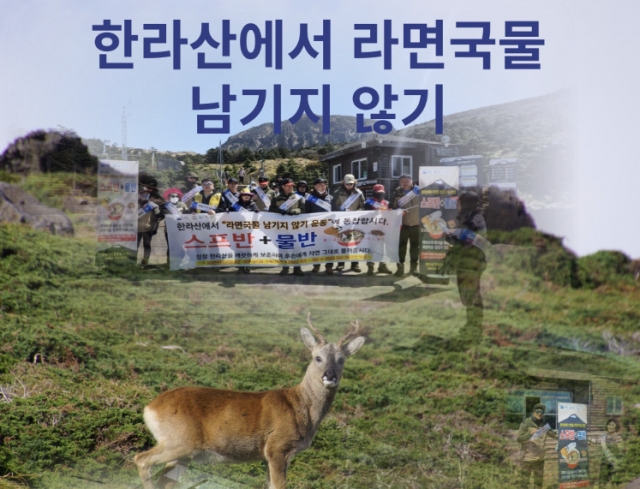
In a post titled ‘What Happens When You Throw Away Ramen Soup in Hallasan Mountain’ on social media, Hallasan National Park urged, “Ramen soup contains a lot of salt, so when it is thrown away along the streams of the valley, the aquatic insects that live in the water cannot live in the contaminated water.” (Image from Hallasan National Park SNS channel)
SEOUL/JEJU, May 6 (Korea Bizwire) -- At 11 a.m. on May 2, some 20 hikers were having an early lunch on the wooden deck of the Witsae oreum shelter, perched 1,700 meters up the slopes of Hallasan, South Korea’s highest mountain.
Most had brought insulated bottles, filling them with hot water to prepare ubiquitous packets of instant ramyeon noodles. Some supplemented the noodles with kimbap (rice rolls) and boiled eggs or chocolate bars.
“After our three-hour hike, savoring this ramyeon with my wife and 11-year-old daughter fills me with a sense of achievement and satisfaction,” said Bang Han-woong, 44, from Gyeonggi Province. “To avoid leaving any food waste, we bought the smaller ramyeon portions, and I’m delighted my daughter didn’t leave a single drop of broth.”
The popularity of eating ramyeon at the summit, fueled by word-of-mouth and photos shared on social media, had previously caused headaches for Jeju Island officials grappling with the problem of discarded, salty broth.
But they can breathe easier now as more hikers are conscientious about not leaving any behind. Dumping the MSG- and salt-laden broth can contaminate the mountain’s soil and streams, harming endemic plants and insects.
According to Jeju’s Hallasan National Park Management Office, while discarded ramyeon broth topped 100 liters per day until February, recent levels have plummeted to just 10 liters — a 90% drop. On this afternoon, a 60-liter food waste bin at Witsae oreum was nearly empty, save for a few dregs coating the bottom.

The popularity of eating ramyeon at the summit, fueled by word-of-mouth and photos shared on social media, had previously caused headaches for Jeju Island officials grappling with the problem of discarded, salty broth.. (Image courtesy of Yonhap)
“Considering the winter hiking season is over and fewer people are eating ramyeon, the fact that almost no food waste is being left is remarkable,” said Ha Sung-hyun, head of the park’s protection division. He credited the newly launched “Half Broth, Half Water” campaign, which urges hikers to prepare ramyeon with just half the usual amount of water if they struggle to finish a full packet.
Banners at Witsae oreum prompted debates, with some hikers proclaiming “Just add half the water!” while others insisted, “I can eat it all.”
Packaged ramyeon became a Hallasan staple in January 1990 when the Witsae oreum and Jindallae shelters and Eorimok shop, run by the Hallasan National Park Staff Welfare Association, began selling it.
The association purchased 300,000 ramyeon packets annually, sometimes even using the mountain’s monorail to transport the stockpiles. During the winter climbing season, ramyeon and fuel for heating water were trucked up daily before snowfall.
Lines of dozens of hikers often snaked in front of the shelters to buy ramyeon and hot water. But in January 2018, the welfare association disbanded after operating the shops for 28 years without approval from the Cultural Heritage Administration, which owns the properties as national assets.
The Witsae oreum and Jindallae shelters, originally built in the 1970s, were demolished and rebuilt before being donated back to the administration in 2009 and 2008, respectively.
Although the ramyeon shops are gone, eating ramyeon on Hallasan remains a popular ritual, which is why discarded leftovers have been an intractable issue for park managers.
In August 2021, officials installed 60-liter bins to collect broth at the mountain shelters, along with two eco-friendly food waste processing machines. Jeju Island has been fining violators 200,000 won for illegally dumping ramyeon broth, under its nature park law.
“It’s gratifying to sense a new atmosphere among hikers of leaving less ramyeon broth behind and properly disposing of other waste,” said Kim Hak-su, director of the Hallasan management office. “Continued vigilance will be needed from our visitors to protect the magnificent natural beauty of Hallasan.”
Ashley Song (ashley@koreabizwire.com)






